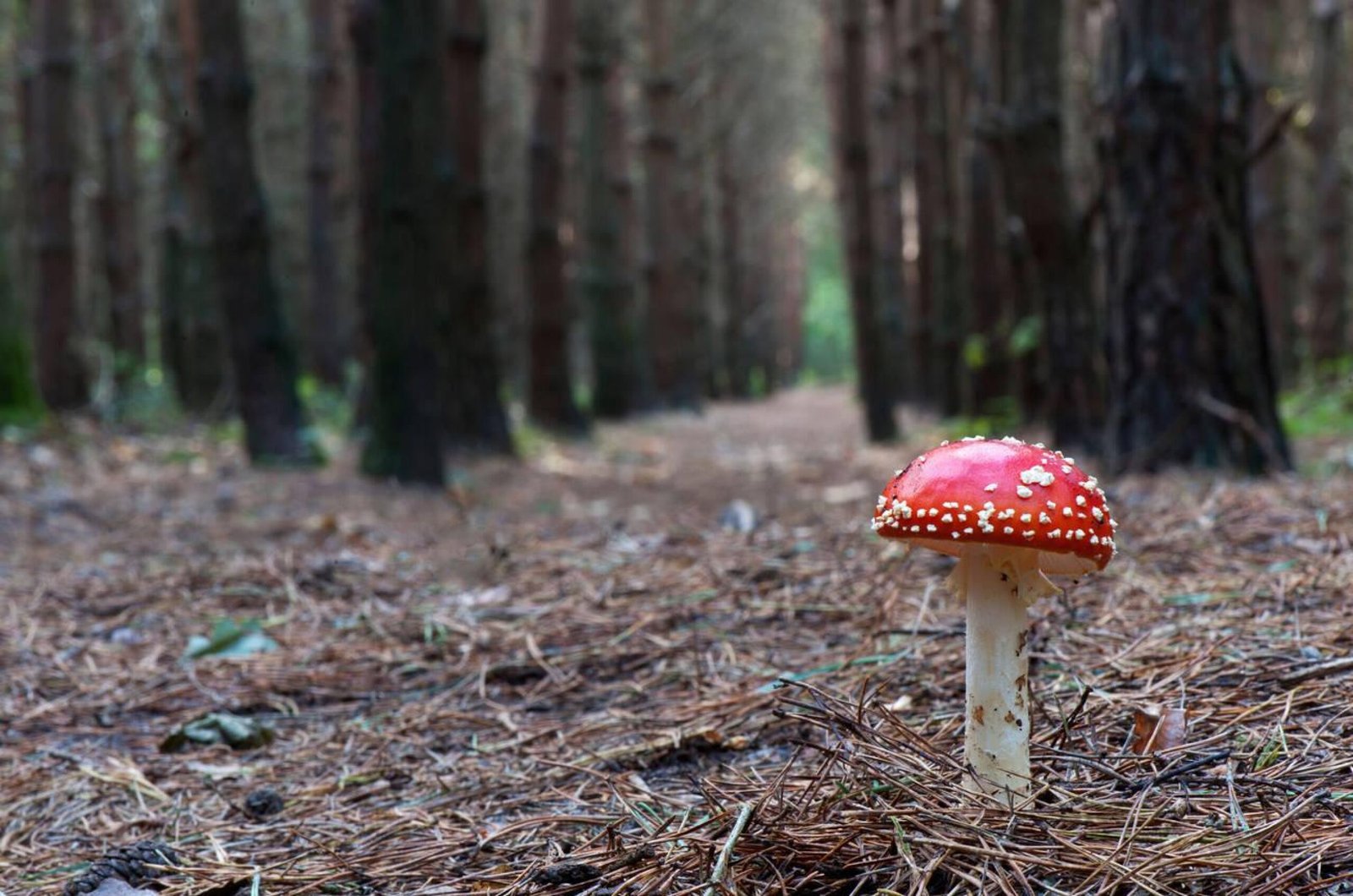Image Credit : Alamy
The Amanita muscaria mushroom, also known as fly agaric, has captivated human imagination for centuries. With its distinctive red cap adorned with white spots, this fungus has played a significant role in various cultures, from ancient Siberian traditions to modern alternative medicine practices. Despite its alluring appearance, the Amanita muscaria mushroom has a reputation for being both poisonous and potentially hallucinogenic, sparking curiosity and concern among researchers and enthusiasts alike.
This article delves into the complex world of Amanita muscaria mushrooms, exploring their historical uses, chemical composition, and effects on the human body. It examines the current legal status and modern applications of these fungi, including the recent trend of Amanita muscaria gummies. Additionally, the piece sheds light on the safety concerns and risks associated with consuming these mushrooms, addressing the ongoing debate about whether they are edible or strictly poisonous. By the end, readers will have a comprehensive understanding of this fascinating yet controversial fungus.
Table of Contents
ToggleHistorical Use of Amanita Muscaria
The Amanita muscaria mushroom, commonly known as fly agaric, has a rich history of use dating back centuries. This distinctive red-capped fungus with white spots has played a significant role in various cultures, particularly in Siberia and other parts of Northern Europe and Asia.
Ancient Shamanic Practices
Shamans in Siberia and other regions have long utilized Amanita muscaria as an entheogen. These spiritual practitioners consumed the mushroom to achieve altered states of consciousness, believing it facilitated communication with the spirit world. In Eastern Siberia, both shamans and laypeople used the mushroom for religious and recreational purposes. Interestingly, some tribes practiced a unique custom where people would drink the urine of shamans who had consumed the mushroom, as it still contained psychoactive compounds but with fewer negative effects.
Traditional Preparation Methods
The preparation of Amanita muscaria varied across cultures. In some Siberian traditions, the mushrooms were dried near the hearth, a practice that may have influenced modern Christmas decorations. The Vedic culture, as described in the Rigveda, had a complex preparation method for a substance called Soma, which some scholars believe to be Amanita muscaria. This process involved mixing the substance with water, beating it with stones, and adding barley or honey.
Cultural Significance
Amanita muscaria held great cultural significance in many societies. The Koryak tribe of Siberia had a creation myth involving the mushroom, believing it to be a sacred gift from a deity. In Celtic traditions, druids reportedly used the mushroom in religious rituals, seeking ancient wisdom and visions of spiritual creatures. The mushroom’s influence extended to folklore, with some speculating that it inspired elements of Christmas traditions, such as Santa Claus’s red and white outfit and flying reindeer.
Chemical Composition and Effects
Active Compounds
The Amanita muscaria mushroom contains several psychoactive compounds that contribute to its effects. The primary active ingredients are muscimol, ibotenic acid, and muscarine. Muscimol, the most potent psychoactive agent in A. muscaria, is a central nervous system depressant that interacts with GABA receptors. It has a high affinity for GABAA-delta receptors and also acts as a partial agonist at the GABAA-rho receptor. Ibotenic acid, on the other hand, interacts with glutamate receptors, producing more stimulating and energizing effects. Muscarine, present in trace amounts, acts on muscarinic acetylcholine receptors in the parasympathetic nervous system.
Physiological and Psychological Effects
The ingestion of Amanita muscaria leads to a range of physiological and psychological effects. Symptoms typically begin between 30 minutes to 2 hours after consumption and can last for 5-24 hours. These effects include confusion, dizziness, agitation, and ataxia. Some individuals may experience nausea, diarrhea, vomiting, tachycardia, bradycardia, and hypertension. In severe cases, hypothermia or hyperthermia and metabolic acidosis may occur.
Psychologically, A. muscaria produces effects similar to alcohol intoxication, including physical relaxation, euphoria, and a “dream-like” state. Users often report blurred vision and loss of motor skills. Some individuals experience visual and auditory hypersensitivity, space distortion, and a feeling of weightlessness. Unlike classical psychedelics, A. muscaria tends to induce a deep sleep state with visions and insights occurring in dreams.
Comparison to Other Psychoactive Mushrooms
Unlike psilocybin-containing mushrooms, Amanita muscaria does not contain psilocybin or psilocin. While psilocybin primarily binds to serotonin receptors and acts as an antidepressant, A. muscaria functions as a depressant, similar to alcohol and benzodiazepines. The effects of A. muscaria are generally considered less hallucinatory and lack the “mind-manifesting” qualities associated with classical psychedelics. This unique profile of effects, combined with potential risks, makes A. muscaria less commonly used as a recreational hallucinogen compared to psilocybin mushrooms.
Modern Uses and Legal Status
Recreational Use
The Amanita muscaria mushroom has gained popularity as a recreational substance in recent years. Google searches for this potentially harmful “magic mushroom” increased by 114 percent from 2022 to 2023, according to a study by researchers at the University of California San Diego. The mushroom produces psychotropic effects similar to those of psilocybin mushrooms, including weightlessness, visual and auditory hypersensitivity, space distortion, and colored hallucinations. These effects are caused by compounds naturally occurring in the mushroom, such as muscimol and ibotenic acid.
Potential Therapeutic Applications
Despite its recreational use, Amanita muscaria has also attracted attention for its potential therapeutic applications. Some researchers believe muscimol could show positive indications for various mental and physical health issues, including sleep disorders, insomnia, addiction, and pain management. However, it is important to note that Amanita muscaria functions as a depressant, similar to alcohol and benzodiazepines, suppressing the central nervous system. This is in contrast to psilocybin, which acts as an antidepressant by binding to serotonin receptors.
Legal Status Worldwide
The legal status of Amanita muscaria varies across different countries. In the United States, it is legal in 49 out of 50 states, with Louisiana being the only exception. Unlike psilocybin mushrooms, Amanita muscaria is not explicitly regulated at the federal level under the Controlled Substances Act. In countries like Sweden, Mexico, Thailand, Ukraine, Russia, and Poland, Amanita muscaria is not classified as a controlled substance. However, it is illegal in Australia, where muscimol is a schedule 9 drug. The Netherlands has banned the buying, selling, or possession of Amanita muscaria since December 2008.
Safety Concerns and Risks
Toxicity and Side Effects
The Amanita muscaria mushroom contains several psychoactive compounds, primarily muscimol and ibotenic acid, which can cause a range of symptoms. These effects typically begin 30 minutes to 2 hours after ingestion and can last for 5-24 hours. Common side effects include confusion, dizziness, agitation, and ataxia. Some individuals may experience nausea, diarrhea, vomiting, and changes in heart rate. In severe cases, hypothermia or hyperthermia and metabolic acidosis may occur.
Proper Identification
Accurate identification of Amanita muscaria is crucial due to the presence of deadly poisonous fungi in the Amanita genus. Even a small taste of a misidentified mushroom could be disastrous. The use of smartphone identification apps has become increasingly common, but these tools are not reliable for excluding exposure to potentially poisonous mushrooms. Studies have shown that the accuracy rate of these apps for identifying all mushroom specimens is only 35-49%, with an even lower rate of 30-44% for poisonous mushrooms.
Harm Reduction Strategies
To minimize risks associated with Amanita muscaria, it is essential to avoid consumption without proper knowledge and guidance. Individuals experiencing adverse effects should seek immediate medical attention. Pet owners should be aware that dogs and cats are attracted to these mushrooms, particularly dried specimens, and ingestion can lead to severe symptoms in animals. For those seeking information or support related to substance use disorders, SAMHSA’s National Helpline provides free, confidential, 24/7 treatment referral and information services in English and Spanish.
Also Read : Influencers Gone Wild: The Controversy and Its Cultural Implications
Conclusion
The Amanita muscaria mushroom has an influence on various aspects of human culture and consciousness. From its historical use in shamanic practices to its potential therapeutic applications, this fungus continues to captivate researchers and enthusiasts alike. The complex chemical composition of A. muscaria has an impact on both the body and mind, producing effects that range from relaxation to altered states of consciousness. However, its use comes with significant risks, including potential toxicity and the challenge of proper identification.
Given the ongoing interest in Amanita muscaria, it’s crucial to approach this mushroom with caution and respect. Its legal status varies worldwide, reflecting the complex nature of its effects and potential dangers. To sum up, while A. muscaria holds a unique place in human history and may offer some benefits, its use requires careful consideration of the associated risks. Further research is needed to fully understand its potential applications and to develop safe, controlled methods for its use.
FAQs
What purposes did Amanita muscaria serve in ancient cultures?
Amanita muscaria mushrooms, known for their hallucinogenic effects, were historically used by indigenous Siberian tribes as an intoxicant and spiritual enhancer. The psychoactive effects are primarily due to compounds like muscimol and ibotenic acid.
What are the harmful effects associated with Amanita muscaria consumption?
Consuming Amanita muscaria can lead to several adverse effects including confusion, dizziness, agitation, ataxia, altered visual and auditory perception, and distorted sense of space and time. Physical symptoms may include nausea, vomiting, diarrhea, changes in heart rate, and fluctuations in body temperature.
How does Amanita muscaria affect the brain?
Ingesting Amanita muscaria can cause a range of neurological effects such as drowsiness or coma, hallucinations, seizures, and excessive salivation, primarily due to the action of muscimol which enhances GABA neurotransmission in the brain. Symptoms like delirium and agitation are typically treated with benzodiazepines, and these effects usually resolve within 24 hours.
Does Amanita muscaria cause liver damage?
Unlike some other species of the Amanita family, Amanita muscaria does not cause liver or kidney damage. While certain Amanita species produce amatoxins that can lead to liver failure, Amanita muscaria contains different toxins (isoxazoles) that affect mental status but do not harm the liver or kidneys.




